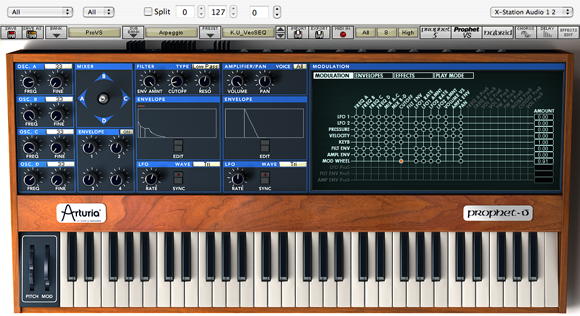Hands-on with Prophet 5
Let’s start by saying that if you’ve ever used the originals, you’ll feel immediately at home with these recreations, which model the panel layouts and feature set nearly exactly. Like the original, the Prophet 5 is a straightforward subtractive synth with two analog oscillators, a white noise module, a low-pass resonant filter, two ADSR envelopes, and a single LFO. The Poly Mod section is the source of much of the original’s power, allowing you to apply frequency modulation to oscillator A and the filter.
The Prophet VS includes 96 digitally sampled waveform types, four digital oscillators, one multi-mode filter (LP, HP, BP, Notch), a pair of LFOs, three 5-point envelopes and a mod matrix (which can also be used with the Prophet 5 in hybrid mode). Arturia has generously included the factory presets from both synths, and if you happen to have any original presets laying around, you can load them into the software via System Exclusive (SysEx).

Two, two, two synths in one: The Prophet 5 not only includes an emulation of the original Prophet, but the VS digital synth, as well.
While all of the classic sounds are easily obtained, these synths are far from relics. The bowel-moving basses, brassy pads, realistic organs and searing unison sawtooth leads are perfect for modern electronic styles and even hard rock, while the Prophet VS is capable of producing complex morphing digital timbres that are ideal for ambient music and film soundtracks. The analog emulation is extremely convincing and the overall sonic oomph of the originals is present in spades.
Hybrid mode allows you to combine the oscillators, filters, and envelopes of the two synths as of you were dealing with a single instrument. You can easily activate or deactivate individual oscillators or filters. The filters can be connected in series or in parallel. The mod matrix even lets you apply modulation sources found on the Prophet VS, such as velocity or aftertouch, to the Prophet 5.
Other improvements over the originals include graphical editing of the VS envelopes. You just click and drag them into place with the mouse, an intuitive exercise that proves that computers are indeed better at some aspects of classical synthesis.
Next: Conclusions